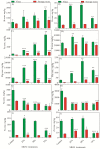Effects of Mars Global Simulant (MGS-1) on Growth and Physiology of Sweet Potato: A Space Model Plant
- PMID: 38202365
- PMCID: PMC10780443
- DOI: 10.3390/plants13010055
Effects of Mars Global Simulant (MGS-1) on Growth and Physiology of Sweet Potato: A Space Model Plant
Abstract
Growing food autonomously on Mars is challenging due to the Martian soil's low nutrient content and high salinity. Understanding how plants adapt and evaluating their nutritional attributes are pivotal for sustained Mars missions. This research delves into the regeneration, stress tolerance, and dietary metrics of sweet potato (Ipomoea batatas) across different Mars Global Simulant (MGS-1) concentrations (0, 25, 50, and 75%). In our greenhouse experiment, 75% MGS-1 concentration significantly inhibited sweet potato growth, storage root biomass, and chlorophyll content. This concentration also elevated the plant tissues' H2O2, proline, and ascorbic acid levels. Higher MGS-1 exposures (50 and 75%) notably boosted the vital amino acids and sugar groups in the plant's storage roots. However, increased MGS-1 concentrations notably diminished the total C:N ratio and elemental composition in both the vines and storage roots. In summary, sweet potato exhibited optimal growth, antioxidant properties, yield, and nutrient profiles at 25% MGS-1 exposure as compared to higher concentrations. This study underscores the need for future interventions, like nutrient enhancements and controlled metal accessibility, to render sweet potato a suitable plant for space-based studies.
Keywords: Mars Global Simulant; amino acids; antioxidant; proline; stress tolerance; sugar classes.
Conflict of interest statement
The authors declare no conflicts of interest.
Figures




Similar articles
-
Foliar application of glycinebetaine regulates soluble sugars and modulates physiological adaptations in sweet potato (Ipomoea batatas) under water deficit.Protoplasma. 2020 Jan;257(1):197-211. doi: 10.1007/s00709-019-01429-4. Epub 2019 Aug 12. Protoplasma. 2020. PMID: 31407117
-
Optimizing sweet potato production: insights into the interplay of plant sanitation, virus influence, and cooking techniques for enhanced crop quality and food security.Front Plant Sci. 2024 Mar 18;15:1357611. doi: 10.3389/fpls.2024.1357611. eCollection 2024. Front Plant Sci. 2024. PMID: 38562562 Free PMC article.
-
Can Lunar and Martian Soils Support Food Plant Production? Effects of Horse/Swine Monogastric Manure Fertilisation on Regolith Simulants Enzymatic Activity, Nutrient Bioavailability, and Lettuce Growth.Plants (Basel). 2022 Dec 2;11(23):3345. doi: 10.3390/plants11233345. Plants (Basel). 2022. PMID: 36501382 Free PMC article.
-
Water-Deficit Tolerance in Sweet Potato [Ipomoea batatas (L.) Lam.] by Foliar Application of Paclobutrazol: Role of Soluble Sugar and Free Proline.Front Plant Sci. 2017 Aug 8;8:1400. doi: 10.3389/fpls.2017.01400. eCollection 2017. Front Plant Sci. 2017. PMID: 28848596 Free PMC article.
-
Sweet potato (Ipomoea batatas [L.] Lam)--a valuable medicinal food: a review.J Med Food. 2014 Jul;17(7):733-41. doi: 10.1089/jmf.2013.2818. Epub 2014 Jun 12. J Med Food. 2014. PMID: 24921903 Review.
References
-
- Duri L.G., El-Nakhel C., Caporale A.G., Ciriello M., Graziani G., Pannico A., Palladino M., Ritieni A., De Pascale S., Vingiani S. Mars regolith simulant ameliorated by compost as in situ cultivation substrate improves lettuce growth and nutritional aspects. Plants. 2020;9:628. doi: 10.3390/plants9050628. - DOI - PMC - PubMed
-
- DeMattio D., McGuire N., Rosa Polonia R.A., Hufendick B.T. Project HOME: Hydroponic Operations for Mars Exploration. Beyond Undergrad. Res. J. 2020;4:5.
-
- Carr M., Head J. Martian surface/near-surface water inventory: Sources, sinks, and changes with time. Geophys. Res. Lett. 2015;42:726–732. doi: 10.1002/2014GL062464. - DOI
Grants and funding
LinkOut - more resources
Full Text Sources
Miscellaneous

